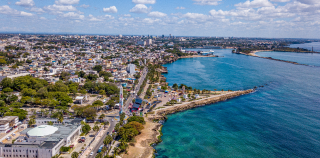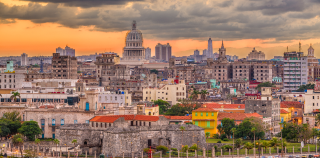- The CDC recommends buying medical evacuation insurance if you are traveling to a remote area or to somewhere that has low-quality medical care that may not be up to U.S. standards.
- Based on our research, the best emergency medical evacuation insurance plans come from: AXA Assistance USA, Seven Corners, Tin Leg, & Cat 70. (skip ahead to view these plans)
- Emergency medical evacuation insurance is built to cover the cost of transporting you to a high-quality hospital via air ambulance or other suitable arrangements and can cost as little as $2 per day.
- Many medevac plans also cover the repatriation of remains, which means if you or a travel companion pass away during a trip, you can be transported home for a proper burial.
- We recommend opting for medical evacuation limits between $250,000 - $1,000,000 because evacuation costs can easily exceed $100,000 in most parts of the world - as outlined here by the CDC.
- We recommend using a comparison tool to compare plans and prices from multiple providers at once.
Best Medical Evacuation Insurance Plans 2024


On This Page
- Key takeaways
- What is emergency medical evacuation insurance?
- Medical evacuation insurance vs. travel medical insurance
- Our top picks for the best medical evacuation insurance plans
- Do I need medical evacuation insurance?
- What does emergency medical evacuation insurance cover?
- How much does a medical evacuation cost without insurance?
- How much emergency evacuation insurance coverage should you have?
- When is medical evacuation coverage recommended?
- Tips for choosing the best medevac insurance
- How to use emergency medical evacuation insurance?
- Air ambulance insurance and other alternatives
- Medical Evacuation Insurance FAQ
- Recommended articles
- Related topics
On This Page
- Key takeaways
- What is emergency medical evacuation insurance?
- Medical evacuation insurance vs. travel medical insurance
- Our top picks for the best medical evacuation insurance plans
- Do I need medical evacuation insurance?
- What does emergency medical evacuation insurance cover?
- How much does a medical evacuation cost without insurance?
- How much emergency evacuation insurance coverage should you have?
- When is medical evacuation coverage recommended?
- Tips for choosing the best medevac insurance
- How to use emergency medical evacuation insurance?
- Air ambulance insurance and other alternatives
- Medical Evacuation Insurance FAQ
- Recommended articles
- Related topics
Emergency medical evacuation insurance, also known as medevac insurance or air ambulance insurance, can save you hundreds of thousands of dollars in case of an emergency while traveling.
For this reason, we consider medevac insurance as one of our most basic coverages to look for when buying travel insurance.
In this guide, we’ll cover:
Not all evacuation coverage is made equal, and many factors can influence whether the plan you purchase will cover you or not.
To help you make the best decision when buying medevac insurance, we have reviewed plans from some of America’s best providers and highlighted our top picks.
So without further delay, here is our selection of the best medical evacuation insurance.
Our top picks for the best medical evacuation insurance




What is emergency medical evacuation insurance?
Emergency medical evacuation insurance, or medevac insurance, is a type of travel insurance coverage that pays for emergency transportation home or to a suitable medical facility when you become sick or injured while traveling.
Medevac coverage is different from travel medical insurance in that it focuses on paying for the journey to a medical facility or transport home after an incident whereas travel health insurance is made to reimburse you for the costs of medical treatment you receive while traveling.
Medical evacuation insurance vs. travel medical insurance
If you plan to take a trip that’s far from where you live, it’s best to have both travel evacuation insurance & travel medical coverage in place.
These insurances work in tandem to cover essential services and treatments while offering entirely separate types of benefits.
- Emergency travel medical insurance: pays for the emergency medical care you receive while you’re away – including doctor bills, lab tests, emergency surgery, etc.
- Emergency medical evacuation insurance: pays for you to be rescued or evacuated mid-travel and will ensure you are transported to a proper medical center for treatment. Also repatriates remains in the event of your death.
- Combining both coverages: The best travel insurance plans combine both of the above coverages into one comprehensive travel insurance package and can also include extras like baggage coverage.
Our top picks for the best medical evacuation insurance plans
Best Medical Evacuation Membership
MedjetAssist
Why We Like It
Editor's take
MedJet Assist is a membership plan that ensures individuals get the medical evacuation help they need when they need it. Paying for membership ensures travelers get help arranging medical transfers regardless of medical necessity, and it lets members determine which medical facility they want to be moved to. This plan works for medical evacuation within the United States and abroad, and it can be purchased for short-term travel or longer trips.
While the traditional MedJet Assist plan includes coverage for medical evacuation, the upgraded MedJetHorizon plan also adds in worldwide travel security, crisis response, and evacuation services powered by FocusPoint International. This add-on coverage can help pay for evacuation in the event of terrorism, natural disasters, and violent crime.
PROS
- Available for short-term or long-term travel
- Can cover pricey evacuation expenses when you need medical care
- Covers both personal and business travel
- Membership covers each trip you take during its term
- Short-term memberships start at just $99
CONS
- Does not include traditional travel insurance benefits
- Does not cover transportation from the site of an accident (medical facility transfers only)
- Covers up to two transport events per year
Best for Budget Friendly Travelers
Tin Leg
Why We Like It
Editor's take
The Tin Leg Gold plan is one of the top-selling plans offered by the acclaimed budget insurance provider Tin Leg. Despite being one of the most affordable insurance providers on the market, Tin Leg is renowned for its high-quality travel insurance coverage at competitive and reasonable prices. The gold plan is an ideal plan for medical evacuation thanks to its extremely high limits and the complementary medical coverage it offers for accidents and illnesses while traveling.
The Gold plan provides up to $500,000 in coverage for emergency medical evacuation & medically necessary repatriation, guaranteeing a safe return in case of emergencies.
Here’s a look at the coverage:
- Expenses for evacuation to a medical facility – including medically necessary transportation, related medical services, and supplies.
- Cost to send one person (chosen by you) to come and accompany you in the hospital if you are hospitalized for an extended time.
- Return transportation costs for dependent children, domestic partner, or spouse.
- Return transportation costs for you once you are healed and can leave the medical facility.
- Medical escort to accompany you back home if you are disabled during your trip.
- Escort to return your dependent children back home if you’re incapacitated or deceased.
- Repatriation of remains in case of death. This can include embalming or cremation before sending, temporary storage costs, shipping of the remains, necessary documentation, consular proceedings, transfer to final destination.
Apart from the extensive medical evacuation coverage, this plan offers up to $500,000 in primary emergency medical treatment coverage, ensuring you receive emergency medical care without deductibles or out-of-pocket expenses. The plan’s medical coverage includes COVID-19 sickness.
Tin Leg Gold also covers pre-existing conditions when purchased within 14 days of booking your trip and insuring the full trip cost. This feature is valuable for older travelers or those with pre-existing health concerns.
This plan also includes comprehensive travel protection in the form of trip cancellation and interruption coverage for various circumstances, including COVID-19.
The plan includes other essential benefits such as coverage for accidental death and dismemberment, as well as sports and adventure activities (with some exclusions). Additionally, it offers coverage for travel delays, missed connections, baggage delays, damage, loss, and sports gear or equipment issues.
While this plan has slightly lower limits for travel delay and baggage coverage compared to other plans, its outstanding medical coverage at an affordable price makes it a compelling choice. With a 14-day money-back guarantee and 24-hour travel assistance service, Tin Leg Gold prioritizes customer satisfaction and support, making it a top pick for travelers who value their well-being and seek comprehensive coverage for their trips.
PROS
- Excellent primary coverage for medical expenses
- High limit for emergency evacuation coverage
- Optional cancel for any reason (CFAR) coverage available
- Comes with coverage for hurricanes and inclement weather
- Coverage for pre-existing conditions is available if purchased within 14 days of the trip deposit
CONS
- Baggage delay coverage requires a 24-hour waiting period
- Low coverage limits for baggage and personal effects
Best for Premium Comprehensive Coverage
AXA Assistance USA
Why We Like It
Editor's take
AXA Assistance USA is a highly-rated travel insurance company that offers comprehensive travel insurance plans with a ton of benefits. This means the coverage you purchase from them includes medical evacuation protection as well as baggage insurance, trip cancellation insurance, trip interruption coverage, travel delay coverage, and more. The company also offers three tiers of coverage you can choose from based on your needs and your budget.
We recommend the Platinum plan from AXA Assistance USA due to its superior medical evacuation coverage and robust limits in other categories. This plan comes with up to $1 million in protection for emergency medical evacuation and repatriation of remains, up to $250,000 in coverage for emergency medical expenses, $300 per day (maximum of $1,250) in trip delay coverage, $3,000 in insurance for baggage and personal effects, and more. Optional cancel for any reason (CFAR) coverage is also available as an add-on with this plan.
PROS
- High coverage limits in every category. Extremely comprehensive
- Includes identity theft coverage & non-medical evacuation coverage
- CFAR coverage reimburses 75% of prepaid travel expenses
CONS
- Coverage cannot be extended unlike other plans
- Medical limit is lower than other cheaper plans, but still sufficient
Best Value
Seven Corners
Why We Like It
Editor's take
The Trip Protection Choice plan from Seven Corners is an excellent choice for a comprehensive plan and offers robust coverage at a great price. In fact, the Trip Protection Choice plan is our top-selling travel insurance policy thanks to its high coverage limits, customizable add-ons, excellent 24-hour customer service, and a 14-day money-back guarantee. This plan is neither the cheapest nor the most expensive, but it offers solid coverage for an affordable price.
Regarding medical coverage, Seven Corners’ Trip Protection Choice plan offers $500,000 for emergency medical coverage and $1m in medical evacuation and repatriation coverage per person. It also covers medical expenses related to Covid-19. The plan’s primary medical coverage also means there is no deductible, and you won’t have to pay out of pocket if any medical emergencies occur during your trip.
The Trip Protection Choice offers extensive medical evacuation and repatriation coverage. Here is what it includes at a glance:
- Emergency Medical Evacuation: Covers transportation expenses for evacuating you to the nearest suitable hospital or medical facility for necessary treatment.
- Medical Repatriation: Covers expenses for sending you back home or to a hospital or medical facility closest to your home for continued treatment.
- Medical Escort: Covers expenses for a medical professional to escort you back to the U.S. and provide medical care during the trip, if necessary.
- Repatriation of Remains: If you die while on the trip this will cover expenses for sending your body back home and can include embalming or local cremation before sending, temporary storage costs, transportation of the remains, and necessary documentation.
- Transportation of Children/Child: Covers the cost of returning your dependent children or minors left unattended due to your hospitalization for 7+ consecutive days or death during the trip. It also ensures they are accompanied and attended to until they arrive home.
- Transportation to Join You: Covers the cost of someone you know to visit your bedside if you are hospitalized for 7+ consecutive days. A daily benefit of up to $1,000 is available for bedside traveling companions.
Apart from this, the Trip Protection Choice plan can easily cover and reimburse you for things like:
- Overall trip cost
- Travel delays & stipends
- Baggage & equipment loss/damage
- Accidental death or dismemberment
You will also be covered for trip cancellations (up to 100%) and interruptions (up to 150%) including a wide range of valid reasons for claiming trip cancellation and interruption benefits. Optional add-ons include coverage for Cancel for Any Reason, Interruption for Any Reason, rental car damage, sports equipment rental, and event ticket protection.
PROS
- Offers coverage for pre-existing conditions
- Money-back guarantee
- Cancellation & Interruption coverage standard
- Covers action sports & equipment
CONS
- Cancel for any reason not included standard
- Must meet waiver for pre-existing conditions to be covered
Best for Affordable Comprehensive Coverage
Cat 70
Why We Like It
Editor's take
Cat 70 offers affordable comprehensive travel coverage with high limits for emergency medical evacuation. This plan is exclusively available through platforms like LA Times Compare.
The Cat 70 Travel Plan is a solid and affordable option for comprehensive travel insurance that also includes ample coverage for medical evacuation. In fact, this plan comes with $500,000 in coverage for emergency medical expenses and up to $500,000 in insurance for emergency medical evacuation. Other benefits include trip cancellation coverage, baggage insurance, travel delay coverage, protection for missed connections, and more.
PROS
- High limits for emergency medical expenses
- Affordable travel insurance with high limits for medical evacuation
- Includes extras like trip cancellation coverage & baggage insurance
CONS
- Not available in all destinations
Do I need medical evacuation insurance?
The US Government’s travel.state.gov website highlights that most traditional health insurance plans will not cover repatriation costs back to the U.S. making evacuation insurance all the more useful to travelers.
Travelex travel insurance reports that medical evacuation costs can average close to $25,000 in North America, or as much as $100,000 in Europe or $250,000 on a global level.
These two factors alone are enough to warrant travel insurance that includes medevac coverage. Without emergency medical evacuation insurance, you could be forced to bear the brunt of these costs by paying out-of-pocket if you needed to be transported by a medevac helicopter, plane, or ambulance for medical treatment.
You should consider opting for medical evacuation coverage if:
- You plan to travel to a remote area where medical facilities may be far away or inadequate
- You have pre-existing health conditions that could flare up and require hospitalization
- You have special healthcare needs that certain facilities may not be able to adequately treat
- There is a higher-than-average risk of you dying or falling seriously ill while away
- You cannot afford to pay the out-of-pocket costs associated with an unexpected medical evacuation
What does emergency medical evacuation insurance cover?
Medical evacuation travel insurance will pay for a range of non-medical and even non-emergency services that can help you overcome an injury or illness when you travel.
The following services are typically covered with emergency medevac coverage:
Emergency transportation to a hospital of your choice
All medical evacuation plans offer coverage to the nearest suitable medical facility equipped to handle your condition. However, most plans allow you to be sent to a hospital of your choice. Transport method depends on your condition but can include a specialized medical plane equipped with a mobile ICU, commercial airplane, helicopter, or ambulance.
COVID coverage & transport care
Most emergency evacuation plans include coverage for COVID-19. If you become severely ill with coronavirus and need to be hospitalized or intubated, you can receive emergency medical transportation in a specialized mobile COVID quarantine unit that will provide adequate care throughout transport to a proper medical facility.
A medical escort for returning home
Your coverage may pay for a medical escort, such as a doctor, to accompany you home safely if you need surgery or medical care as a result of your emergency. This means you won’t be stuck traveling home alone, which can be a major blessing when you’re sick or injured and require extra assistance.
Return travel costs for your children
If you pass away or become hospitalized and require care during your trip, evacuation coverage can pay for a return ticket for your dependent children who were traveling with you. Your plan can also provide them with a travel escort if one is required.
Bedside companion’s room and board
If you are ill or injured and require hospitalization, **some emergency medical evacuation plans cover non-medical expenses** like your bedside companion’s room and board so your travel companion can accompany you as you receive proper treatment. It’s important to read over your policy and check to make sure coverage extends to travel companions and not just the patient.
Travel expenses for a family member or friend to reach you
If you are alone and become hospitalized at your travel destination for a longer period of time (usually seven nights or longer) your emergency coverage may pay for a family member to travel to visit you. This non-emergency protection can pay for a plane ticket to where you are located, as well as meals, hotel stays, and incidental travel expenses incurred by your companion.
Repatriation of remains
Finally, you should know that your evacuation plan can pay to have your body returned home if you pass away during your vacation. In addition to covering the travel expenses for your remains, medical evacuation and repatriation insurance can also cover embalming, local cremation, and a basic casket for transportation.
How much does a medical evacuation cost without insurance?
The costs for medical evacuations can be astronomical and can add up to hundreds of thousands of dollars.
Travel insurance guidelines from the CDC state the following:
“The total cost of medevac varies by location, ranging from $25,000 for transport within North America to ≥$250,000 for more distant and remote locations. Costs increase when the patient being evacuated is critically ill or needs complex infection control measures.”
It’s best to anticipate that when traveling abroad you could end up paying $250,000 or more for an international transfer to a U.S. facility to receive medical attention.
Ultimately, this is why many travel insurance plans with emergency medical evacuation coverage have limits of up to $500,000 or even $1 million for emergency transport.
With emergency medical evacuation protection in place, there may be zero out-of-pocket expenses associated with this care. In other cases, your costs may be limited to the travel insurance deductible amount or a few hundred dollars.
How much emergency evacuation insurance coverage should you have?
How much coverage you should have for travel evacuation insurance depends heavily on the destination and traveler profile.
| Travel Destination | Recommended Medevac Limits |
|---|---|
| Within the US | $25,000 or more |
| North America & Caribbean | $50,000 or more |
| Other International Destinations | $250,000 or more |
For U.S. domestic travel, it’s good to have at least $25,000 in medical evacuation coverage, but we recommend opting for around $50,000 in coverage – based on information outlined by the U.S. Government and the CDC.
Generally speaking, it’s best to have protection with limits that are robust enough to cover nearly any medical emergency that pops up. That said, medical evacuation limits below $250,000 are likely not enough for international trips.
Travel insurance doesn’t have to break the bank. There are many cheap travel insurance plans that include medical evacuation coverage for extra peace of mind while traveling.
Cancel for any reason (CFAR) coverage or annual travel plans can also be added to certain plans for additional coverage.
When is medical evacuation coverage recommended?
Medical evacuation insurance is recommended any time you travel out of your home country where your normal health insurance does not apply.
There are other scenarios where you’ll want to ensure your coverage for emergency medical evacuation is especially robust, such as if you plan to participate in high-risk adventure sports or if you’re traveling in an extremely remote area of Spain, for example. In these cases, it is definitely worth it to consider travel insurance specific to medical emergencies.
For example, if you plan to hike the French Alps and you’ll be miles from the largest city on the side of a mountain, having emergency medical evacuation coverage is crucial. The same is true if you plan to go hang gliding or deep sea diving on your trip to Bali, but also if you plan to do nothing more than relax and sightsee on your trip.
We also recommend medical evacuation coverage if you are going on a cruise since being evacuated from a ship is very costly. Check out our recommendations for cruise insurance to make sure you’re covered when setting sail.
The fact is, you never know when you may be in an automobile accident, or if you’ll come down with COVID-19 or another illness during your travels. Your health is one of your biggest assets, so it’s best to provide yourself with adequate protection just in case.
Do you need medevac insurance coverage for trips in the U.S.?
Even if you are traveling within the United States, medical evacuation insurance can come in handy.
This is especially true for the add-ons and additional coverage that medical evacuation insurance provides like repatriation services, and more.
For example, if you’re traveling full-time or part-time in remote areas of the United States, your health insurance plan may pay for your medical care but not necessarily your travel back home.
Imagine hiking in Yellowstone National Park and being injured from a fall. Your normal health insurance plan would likely cover an ambulance ride to the nearest hospital and your immediate medical care. However, your health insurance plan would not cover your plane ride home, or an escort if you need help with the journey due to your condition. This is particularly important for those who are at a higher risk of injury or illness, like senior citizens.
This is true whether you have health insurance through a private provider, or if you get insurance through a federal plan such as Medicare or Medicaid. If you aren’t covered by health insurance in the United States, then medical evacuation insurance becomes even more important.
By having adequate emergency medical insurance and medical evacuation insurance in place, you can enjoy your travels and worry less about unforeseen accidents.
Tips for choosing the best medevac insurance
As with anything, it helps to know what to look for as some plans and providers are better than others.
To help you choose, we have come up with the main things to look for when buying medical evacuation insurance.
Read over the fine print
Travel insurance is notorious for including many exceptions for coverage in the fine print. While it may be a pain, make sure to read over the fine print and all details of the policy from start to finish. Ensure the company offers adequate limits for each type of insurance you want to buy. It can also help to look for companies that offer travel assistance, such as 24-hour emergency assistance services.
Check what is excluded from the policy
If you plan to participate in high-risk adventure sports during your trip, make sure your travel insurance plan covers these activities. Each plan has different requirements relating to action sports, so check that it does not list your sport as an exclusion. Also, note that some plans exclude coverage in certain countries or regions of the world.
Opt for plans that also cover medical expenses
Make sure your policy has robust limits for medical expenses that might appear during travel, including expenses caused by accidents, illness, emergency dental treatment, and any other care you receive.
Check coverage for pre-existing conditions
Many plans will cover pre-existing conditions if you meet certain criteria – such as booking within a certain time frame. That said, pre-existing conditions are commonly excluded from travel insurance coverage or come with strings attached. Make sure you understand if you can be fully covered before buying.
Understand the dollar limits
Make sure you have a full understanding of all the limits listed in your travel insurance policy, and determine what the specific limits are on the emergency evacuation coverage for plans you’re considering. Ideally, you’ll select a high-quality policy that offers generous limits for emergency evacuation and medical expenses.
Review the hospital selection policy
Note that most emergency medical evacuation plans will pay for necessary transportation to the nearest appropriate medical facility, which may not be the hospital of your choice. Others allow you to choose where you want to be sent. Be sure you know and understand your plan’s policy ahead of time, and don’t be afraid to consider alternatives if you want to choose where you receive care.
Use a comparison tool
Using a comparison tool allows you to see many plans all at once. This can also allow you to filter and sort plans based on the types of coverage you find most appealing. By using a comparison tool, you’ll be able to quickly eliminate plans that don’t meet your needs and narrow down which ones are the best options.
How to use emergency medical evacuation insurance?
The first step involved in benefiting from this coverage is making sure you have it, and checking to confirm your medevac insurance has adequate limits that can protect you financially when you need it most.
Steps required to use emergency medical evacuation insurance include the following:
Call for approval immediately
Each provider offers a 24-hour hotline you or the in-house doctor or medical professional can call to expedite the process, and you’ll want to do this right away. If you become sick or injured during a trip and require emergency medical transportation, you’ll need to get approval from your travel insurance provider first before using this service.
Wait for evacuation
Your provider will proceed to assist you and manage your medical evacuation and repatriation. They will coordinate with local doctors to monitor your condition and provide adequate medical support for evacuating you home to the US. As an example, this could include an air ambulance equipped with an on-board ICU, or a business class ticket with a medical escort.
Save all bills and receipts
In some cases, your travel insurance plan will pay your medical transportation bills directly. In others, you may have to pay for some of your care upfront and then wait to be reimbursed afterward. Either way, you’ll want to save all documents and receipts relating to your incident or illness, including all bills and paperwork that prove your medical expenses.
File a claim online or over the phone
Once you arrive home, you should call your travel insurance provider to find out where you’re at in the claims process. You may need to file an individual claim for the emergency medical evacuation and other services you used from your plan, or you may only need to provide the company with supporting documentation to use your coverage.
Air ambulance insurance and other alternatives
If you want comprehensive medical evacuation coverage but you’re not thrilled with the options you’re finding online, consider these alternatives.
Medjet: Medjet Assist is primarily an evacuation and air ambulance insurance. This company only covers medical evacuations and it can be purchased in addition to a traditional travel insurance plan. One of the biggest benefits of Medjet is the fact you get to select the hospital you’re transported to for medical treatment. See our full MedJet insurance review for more info.
Global Rescue: Global Rescue is another air ambulance insurance provider that offers standalone coverage for emergency evacuation, which can include ambulance transportation, commercial air travel, and more. Worldwide field rescue, 24-7 travel emergency assistance services, and advisory services are also included in this coverage based on eligibility.
Premium Travel Insurance Plans: The cost of travel insurance will vary by many factors, one of which being the level of coverage you choose. Comprehensive travel insurance plans tend to cost more, but you may get a higher level of emergency evacuation coverage with more options and benefits in exchange. These plans can be purchased for long-term travel, or on a short-term basis for individual trips.
Travel Credit Card Coverage: Finally, you may be able to get medical evacuation insurance with a credit card if you’re eligible. While a handful of travel credit cards offer this coverage, the Chase Sapphire Reserve® offers one of the most comprehensive plans with coverage for medical services and transportation in amounts up to $100,000.
Medical Evacuation Insurance FAQ
Do I need medical evacuation and travel medical insurance?
If you are traveling to a location where you don’t have health insurance, purchasing medical evacuation coverage and insurance for medical expenses is crucial.
It’s best to have evacuation coverage and travel medical insurance if you become injured or come down with an illness and require care when you’re away from home. Having both types of coverage ensures your evacuation is handled adequately, and that you receive professional medical attention from a licensed provider or doctor in a medical facility.
Do credit cards have medical evacuation insurance included?
Some credit cards come with emergency medical evacuation coverage, but these protections usually have limitations. For example, the insurance coverage you get through a credit card typically comes with lower limits than if you were to purchase from a travel insurance provider.
Also, credit card insurance requires you to pay for your trip, including all prepaid travel expenses, with the credit card for their coverage to apply. In other words, just carrying the credit card or having it in your name isn’t enough to be covered by the card’s insurance policy.
Is Medjet Assist any good?
Medjet Assist is only an air ambulance insurance service, meaning it only offers evacuation and will not pay for other medical bills relating to treatment of illness or injury. This service is good for people with a high risk of needing evacuations and is apt for long-term trips or annual coverage. That said, a comprehensive travel insurance plan that includes medevac coverage and medical treatment coverage is usually a better fit for most travelers.





























































